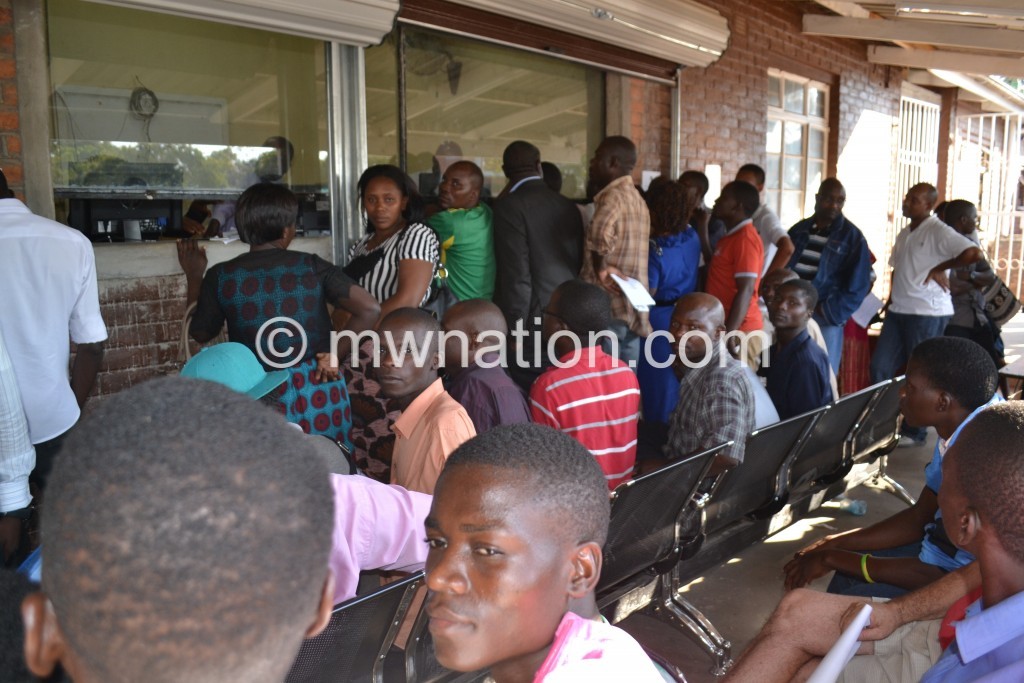Pain, more pain in Maltis
This year, the Department of Road Traffic Safety Services (DRTSS) rolled out the Malawi Traffic Information System (Maltis). ALBERT SHARRA spent two days at the DRTSS offices in Blantyre and shares the experience:
It is around 6am on Monday at the DRTSS in Blantyre, and the gates are closed, but chaos is already brewing, as service seekers jostle and argue for best positions.
There are queues on both sides of the entrance to DRTSS, vehicles are parked orderly to show who came earlier. There are four queues. Slowly, the queues are getting longer and everyone is minding how to keep their position.

“I was here before these cars. Know that I am in front of you,” one of the service seekers shouts, while pointing at some cars parked near the entry point.
Although Maltis was set up to check long queues and other inefficiencies in the old system, the queues refuse to die at the DRTSS.
There are no shortcuts. Neither should users think they will jump the queue or take just a few hours to process documents. The only solution is to come earlier and endure being on long queues.
“This is the third time I am here. I have been on the queues since 7am. They are about to close, but I don’t know if I will finish the process today,” explained Simbarashe Dulani, who had come to renew a certificate of fitness (CoF) for his vehicle.
He explains that he began by applying for a traffic registered card (TRC), which is mandatory. Dulani says due to network hitches, he did not finish the process on the first day and was asked to come the following day, Saturday.
To obtain the card, the applicant goes through four stages. The first step is to collect a form, but this is not as simple as it sounds due to congestion. It is the same story with the second stage where the applicant’s photograph and finger prints are entered into the system. There are hardly short queues at this stage, but according to officials in the room, the main setback is asymmetrical network service.
The third step is the payment at the NBS bank satellite agency situated in the DRTSS premises. Unlike other steps where, when you are nearer the service access point, you have a chance to sit on the chairs, here you have to endure standing to the end.
For those applying for CoF, they have to queue at the bank twice. There is no shade and customers stand in the sun. Unfortunately, it is here where all payments are made. All service seekers meet here and this makes the line long, but also slow.
“I was here in the morning to pay the first fee [K3 000]. I am back for a second payment [K10 000] for the same service. This system is a whack. Why not just combine the CoF payments?” wonders Dulani, while walking to the last stage where finger prints are verified and documents issued.
As he expected to walk home, Dulani faces another hitch. The system failed to recognise the payment and he was told to wait until the payment shows in the system.
“I have a bank deposit receipt, but they say the details are not yet transferred from the bank,” explained Dulani.
Most baffling is the CoF process, especially when it comes to merging the vehicle with the details on TRC. It is even harder if the car is registered in someone’s name as you have to follow different processes that also include the legal process to authenticate ownership.
“They say I should go to police first,” laments Joseph Gama, who claims the car belongs to his deceased son and he has renewed the CoF thrice before.
He adds that he was told that there is need to engage Anti Corruption Bureau (ACB), but the process takes more than a month.
Another customer Virginia Ngondola, says she bought a car from an Indian who went back to his country. She was told to bring the former owner to enter the finger prints for the DRTSS to transfer ownership.
So too is one of those who drive loaned cars from the bank. They are being asked to wait for the officials to delete the title holder information and replace it with owner’s details. For those buying new cars, they have to go to police (Interpol) and Malawi Revenue Authority (MRA) before the vehicle is finally registered.
Errors too are the order of the day at DRTSS. Some details are being lost. Other documents are coming out with wrong information. While the system recognises the use of proxy, a substitute person you can use to process the services on your behalf, the story on the counters is different. The system fails to recognise some.
Under test is hospitality and customer care. There is no one to welcome you and give instructions. During our stay at the Blantyre offices, we saw people being sent back after being on wrong queues. Even at the counters, hardly would one think the services being provided are paid for. Some customers who came unprepared or tried to attend to a phone call were being shouted at or told to go and come when prepared to concentrate.
DRTSS through its advert published in The Nation of September 21, 2015 admits irregularities with Maltis and points out at long queues, power outages, high aptitude test failure rate, lack of vehicle inspection space, inadequate equipment such as computers and scanners and delay in change of vehicle ownership as major reasons for the hustle.
But why push the pain on the road user?





